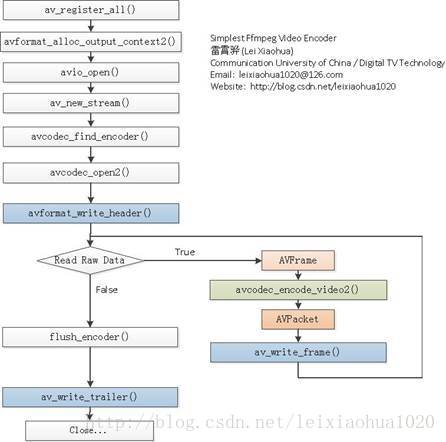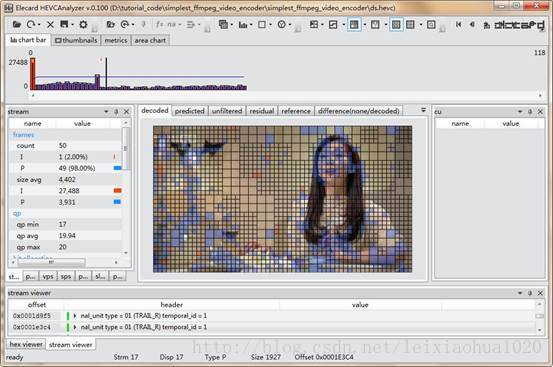最简单的基于FFmpeg的视频编码器-更新版(YUV编码为HEVC(H.265))
=====================================================
最简单的基于FFmpeg的视频编码器文章列表:
最简单的基于FFMPEG的视频编码器(YUV编码为H.264)
最简单的基于FFmpeg的视频编码器-更新版(YUV编码为HEVC(H.265))
最简单的基于FFmpeg的编码器-纯净版(不包含libavformat)
=====================================================
前一阵子做过一个基于FFmpeg的视频编码器的例子:
最简单的基于FFMPEG的视频编码器(YUV编码为H.264)在该例子中,可以将YUV像素数据(YUV420P)编码为H.264码流。因为如今FFmpeg已经实现了对libx265的支持,因此对上述编码H.264的例子进行了升级,使之变成编码H.265(HEVC)的例子。
比较早的FFmpeg的类库(大约几个月以前的版本,我这里编译时间是2014.05.06)对H.265的编码支持有问题。开始调试的时候,以为是自己的代码有问题,几经修改也没有找到解决方法。最终发现是类库本身的问题,更换新版本的类库(我这里编译时间是2014.09.16)后问题解决。
流程
下面附上一张FFmpeg编码视频的流程图。通过该流程,不仅可以编码H.264/H.265的码流,而且可以编码MPEG4/MPEG2/VP9/VP8等多种码流。实际上使用FFmpeg编码视频的方式都是一样的。图中蓝色背景的函数是实际输出数据的函数。浅绿色的函数是视频编码的函数。
简单介绍一下流程中各个函数的意义(上一篇YUV编码为H.264的文章中已经写过一遍,这里复制粘贴一下):
av_register_all():注册FFmpeg所有编解码器。
avformat_alloc_output_context2():初始化输出码流的AVFormatContext。
avio_open():打开输出文件。
av_new_stream():创建输出码流的AVStream。
avcodec_find_encoder():查找编码器。
avcodec_open2():打开编码器。
avformat_write_header():写文件头(对于某些没有文件头的封装格式,不需要此函数。比如说MPEG2TS)。
avcodec_encode_video2():编码一帧视频。即将AVFrame(存储YUV像素数据)编码为AVPacket(存储H.264等格式的码流数据)。
av_write_frame():将编码后的视频码流写入文件。
flush_encoder():输入的像素数据读取完成后调用此函数。用于输出编码器中剩余的AVPacket。
av_write_trailer():写文件尾(对于某些没有文件头的封装格式,不需要此函数。比如说MPEG2TS)。
代码
下面直接贴上代码/**
* 最简单的基于FFmpeg的视频编码器
* Simplest FFmpeg Video Encoder
*
* 雷霄骅 Lei Xiaohua
* [email protected]
* 中国传媒大学/数字电视技术
* Communication University of China / Digital TV Technology
* http://blog.csdn.net/leixiaohua1020
*
* 本程序实现了YUV像素数据编码为视频码流(HEVC(H.265),H264,MPEG2,VP8等等)。
* 是最简单的FFmpeg视频编码方面的教程。
* 通过学习本例子可以了解FFmpeg的编码流程。
* This software encode YUV420P data to HEVC(H.265) bitstream (or
* H.264, MPEG2, VP8 etc.).
* It's the simplest video encoding software based on FFmpeg.
* Suitable for beginner of FFmpeg
*/
#include
extern "C"
{
#include "libavutil\opt.h"
#include "libavcodec\avcodec.h"
#include "libavformat\avformat.h"
#include "libswscale\swscale.h"
};
int flush_encoder(AVFormatContext *fmt_ctx,unsigned int stream_index)
{
int ret;
int got_frame;
AVPacket enc_pkt;
if (!(fmt_ctx->streams[stream_index]->codec->codec->capabilities &
CODEC_CAP_DELAY))
return 0;
while (1) {
printf("Flushing stream #%u encoder\n", stream_index);
//ret = encode_write_frame(NULL, stream_index, &got_frame);
enc_pkt.data = NULL;
enc_pkt.size = 0;
av_init_packet(&enc_pkt);
ret = avcodec_encode_video2 (fmt_ctx->streams[stream_index]->codec, &enc_pkt,
NULL, &got_frame);
av_frame_free(NULL);
if (ret < 0)
break;
if (!got_frame){
ret=0;
break;
}
printf("Succeed to encode 1 frame! 编码成功1帧!\n");
/* mux encoded frame */
ret = av_write_frame(fmt_ctx, &enc_pkt);
if (ret < 0)
break;
}
return ret;
}
int main(int argc, char* argv[])
{
AVFormatContext* pFormatCtx;
AVOutputFormat* fmt;
AVStream* video_st;
AVCodecContext* pCodecCtx;
AVCodec* pCodec;
uint8_t* picture_buf;
AVFrame* picture;
int size;
//FILE *in_file = fopen("src01_480x272.yuv", "rb"); //Input YUV data 视频YUV源文件
FILE *in_file = fopen("ds_480x272.yuv", "rb"); //Input YUV data 视频YUV源文件
int in_w=480,in_h=272;//宽高
//Frames to encode
int framenum=100;
//const char* out_file = "src01.h264"; //Output Filepath 输出文件路径
//const char* out_file = "src01.ts";
//const char* out_file = "src01.hevc";
const char* out_file = "ds.hevc";
av_register_all();
//Method1 方法1.组合使用几个函数
pFormatCtx = avformat_alloc_context();
//Guess Format 猜格式
fmt = av_guess_format(NULL, out_file, NULL);
pFormatCtx->oformat = fmt;
//Method 2 方法2.更加自动化一些
//avformat_alloc_output_context2(&pFormatCtx, NULL, NULL, out_file);
//fmt = pFormatCtx->oformat;
//Output Format 注意输出路径
if (avio_open(&pFormatCtx->pb,out_file, AVIO_FLAG_READ_WRITE) < 0)
{
printf("Failed to open output file! 输出文件打开失败");
return -1;
}
video_st = avformat_new_stream(pFormatCtx, 0);
video_st->time_base.num = 1;
video_st->time_base.den = 25;
if (video_st==NULL)
{
return -1;
}
//Param that must set
pCodecCtx = video_st->codec;
//pCodecCtx->codec_id =AV_CODEC_ID_HEVC;
pCodecCtx->codec_id = fmt->video_codec;
pCodecCtx->codec_type = AVMEDIA_TYPE_VIDEO;
pCodecCtx->pix_fmt = PIX_FMT_YUV420P;
pCodecCtx->width = in_w;
pCodecCtx->height = in_h;
pCodecCtx->time_base.num = 1;
pCodecCtx->time_base.den = 25;
pCodecCtx->bit_rate = 400000;
pCodecCtx->gop_size=250;
//H264
//pCodecCtx->me_range = 16;
//pCodecCtx->max_qdiff = 4;
//pCodecCtx->qcompress = 0.6;
pCodecCtx->qmin = 10;
pCodecCtx->qmax = 51;
//Optional Param
pCodecCtx->max_b_frames=3;
// Set Option
AVDictionary *param = 0;
//H.264
if(pCodecCtx->codec_id == AV_CODEC_ID_H264) {
av_dict_set(?m, "preset", "slow", 0);
av_dict_set(?m, "tune", "zerolatency", 0);
}
//H.265
if(pCodecCtx->codec_id == AV_CODEC_ID_H265){
av_dict_set(?m, "x265-params", "qp=20", 0);
av_dict_set(?m, "preset", "ultrafast", 0);
av_dict_set(?m, "tune", "zero-latency", 0);
}
//Dump Information 输出格式信息
av_dump_format(pFormatCtx, 0, out_file, 1);
pCodec = avcodec_find_encoder(pCodecCtx->codec_id);
if (!pCodec){
printf("Can not find encoder! 没有找到合适的编码器!\n");
return -1;
}
if (avcodec_open2(pCodecCtx, pCodec,?m) < 0){
printf("Failed to open encoder! 编码器打开失败!\n");
return -1;
}
picture = avcodec_alloc_frame();
size = avpicture_get_size(pCodecCtx->pix_fmt, pCodecCtx->width, pCodecCtx->height);
picture_buf = (uint8_t *)av_malloc(size);
avpicture_fill((AVPicture *)picture, picture_buf, pCodecCtx->pix_fmt, pCodecCtx->width, pCodecCtx->height);
//Write File Header 写文件头
avformat_write_header(pFormatCtx,NULL);
AVPacket pkt;
int y_size = pCodecCtx->width * pCodecCtx->height;
av_new_packet(&pkt,y_size*3);
for (int i=0; idata[0] = picture_buf; // 亮度Y
picture->data[1] = picture_buf+ y_size; // U
picture->data[2] = picture_buf+ y_size*5/4; // V
//PTS
picture->pts=i;
int got_picture=0;
//Encode 编码
int ret = avcodec_encode_video2(pCodecCtx, &pkt,picture, &got_picture);
if(ret < 0){
printf("Failed to encode! 编码错误!\n");
return -1;
}
if (got_picture==1){
printf("Succeed to encode 1 frame! 编码成功1帧!\n");
pkt.stream_index = video_st->index;
ret = av_write_frame(pFormatCtx, &pkt);
av_free_packet(&pkt);
}
}
//Flush Encoder
int ret = flush_encoder(pFormatCtx,0);
if (ret < 0) {
printf("Flushing encoder failed\n");
return -1;
}
//Write file trailer 写文件尾
av_write_trailer(pFormatCtx);
//Clean 清理
if (video_st){
avcodec_close(video_st->codec);
av_free(picture);
av_free(picture_buf);
}
avio_close(pFormatCtx->pb);
avformat_free_context(pFormatCtx);
fclose(in_file);
return 0;
} 结果
软件运行截图(受限于文件体积,原始YUV帧数只有100帧):
这次换了个有趣点的YUV序列。之前总是看YUV标准测试序列都已经看烦了,这次换个电视剧里的序列相对更加生动一些。YUV序列如下图所示。
编码后的HEVC(H.265)码流:下载
Simplest ffmpeg video encoder
项目主页
SourceForge:https://sourceforge.net/projects/simplestffmpegvideoencoder/
Github:https://github.com/leixiaohua1020/simplest_ffmpeg_video_encoder
开源中国:http://git.oschina.net/leixiaohua1020/simplest_ffmpeg_video_encoder
CSDN下载地址:http://download.csdn.net/detail/leixiaohua1020/8001515
本程序实现了YUV像素数据编码为视频码流(H.265,H264,MPEG2,VP8等等)。是最简单的FFmpeg视频编码方面的教程。
它包含以下两个子项目:
simplest_ffmpeg_video_encoder:最简单的基于FFmpeg的视频编码器。使用libavcodec和libavformat编码并且封装视频。simplest_ffmpeg_video_encoder_pure:最简单的基于FFmpeg的视频编码器-纯净版。仅使用libavcodec编码视频,不使用libavformat。
更新-1.1 (2015.1.03)=========================================
增加了《最简单的基于FFmpeg的编码器-纯净版(不包含libavformat)》中的simplest_ffmpeg_video_encoder_pure工程。
CSDN下载地址:http://download.csdn.net/detail/leixiaohua1020/8322003
更新-1.2 (2015.2.13)=========================================
这次考虑到了跨平台的要求,调整了源代码。经过这次调整之后,源代码可以在以下平台编译通过:
VC++:打开sln文件即可编译,无需配置。
cl.exe:打开compile_cl.bat即可命令行下使用cl.exe进行编译,注意可能需要按照VC的安装路径调整脚本里面的参数。编译命令如下。
::VS2010 Environment
call "D:\Program Files\Microsoft Visual Studio 10.0\VC\vcvarsall.bat"
::include
@set INCLUDE=include;%INCLUDE%
::lib
@set LIB=lib;%LIB%
::compile and link
cl simplest_ffmpeg_video_encoder.cpp /link avcodec.lib avformat.lib avutil.lib ^
avdevice.lib avfilter.lib postproc.lib swresample.lib swscale.lib /OPT:NOREFMinGW:MinGW命令行下运行compile_mingw.sh即可使用MinGW的g++进行编译。编译命令如下。
g++ simplest_ffmpeg_video_encoder.cpp -g -o simplest_ffmpeg_video_encoder.exe \
-I /usr/local/include -L /usr/local/lib \
-lavformat -lavcodec -lavutilGCC:Linux或者MacOS命令行下运行compile_gcc.sh即可使用GCC进行编译。编译命令如下。
gcc simplest_ffmpeg_video_encoder.cpp -g -o simplest_ffmpeg_video_encoder.out \
-I /usr/local/include -L /usr/local/lib -lavformat -lavcodec -lavutilPS:相关的编译命令已经保存到了工程文件夹中
CSDN下载地址:http://download.csdn.net/detail/leixiaohua1020/8444967
SourceForge上已经更新。



